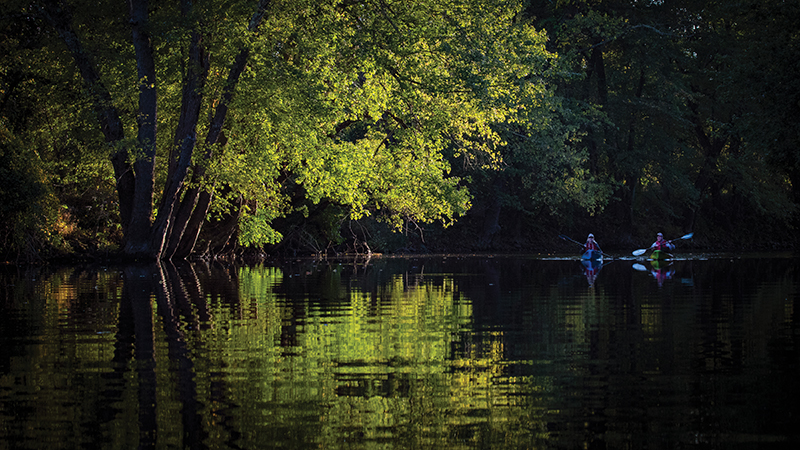
Dancing reflections along the river delivers an everchanging light show for those lucky enough to get out there.
Wild and Scenic
Federal Designations and
Community Commitment
Saved the Farmington River
for Generations to Come
By Bill Hobbs | Photos by Rick Warters
Tucked away in the Northwest corner of Connecticut flows a river that once was deemed “unsuitable and undrinkable.” Remarkably, this same waterway, the Farmington River, today provides a major recreational paradise, one of the top trout fishing rivers in New England, and clean drinking water for nearly one million people in Hartford County.
This is the enduring and awe-inspiring story of how 33 towns; seven municipal, state, and federal organizations; and many caring citizens and volunteers came together to protect and preserve the Farmington River and help it become federally designated as a “wild and scenic” river. Today, only about 230 rivers in the US have attained this distinction.
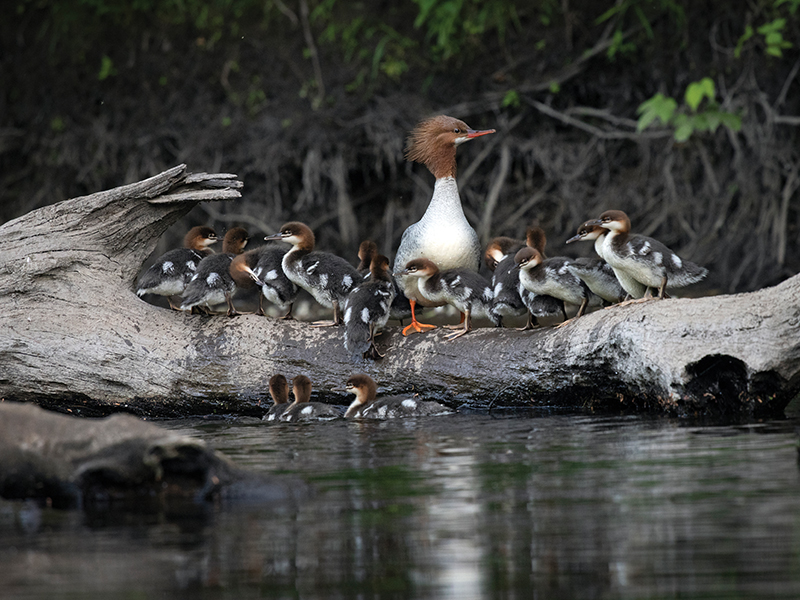
A female common merganser and her brood of sixteen ducklings take a break from feeding along river.
It’s remarkable to watch the progression as the mother teaches survival by example.
The Farmington River’s impressive accolades include two “wild and scenic” designations: one in 1994 for the Upper Farmington River from Colebrook to Canton, totaling 15.1 river miles; the other in 2019 for the Lower Farmington River and Salmon Brook from Canton to Windsor, where it tumbles into the Connecticut River, totaling 61.7 miles.
The Farmington River is the longest tributary of the Connecticut River, meandering from its source near Otis, Massachusetts to Windsor, Connecticut. Now, thanks to the dedicated work of many stakeholders, 76 miles are protected and preserved for generations to come.
Historical Background of the Farmington River Region
The Farmington River Region has a long, rich history. The home of the oldest known human occupation in the Northeast, for example, is in Avon, dating from nearly 12,500 years ago.
In the seventeenth through nineteenth centuries, communities along the river valley were settled because of the waterway, combined with the surrounding natural resources.
In 1633, Lieutenant William Holmes, a 23-year-old soldier and Freeman from Plymouth Colony, led a party up the Connecticut River in a small boat, sailing past the Dutch trading post in Hartford, founding Windsor, the first English settlement in Connecticut, near the confluence of the Connecticut and Farmington Rivers.
Burlington, settled in 1636, is the home of the Burlington State Fish Hatchery, where 100,000 pounds of trout and salmon are raised each year to stock area streams and brooks, including the Farmington River.
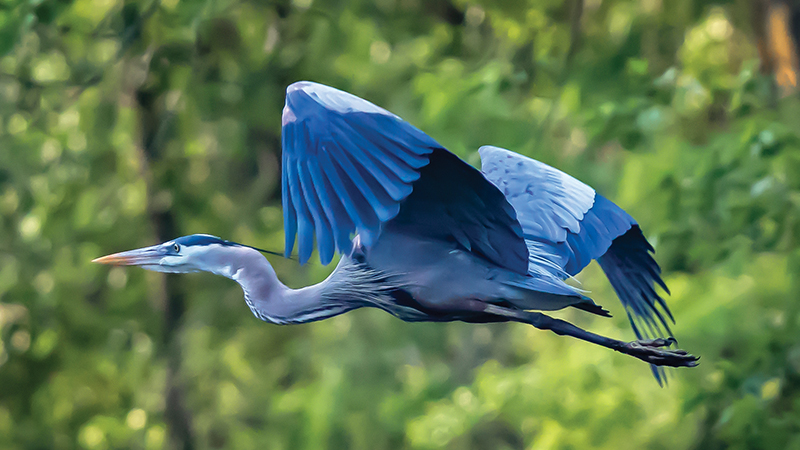
The river comes alive with damselflies and dragonflies in the summer months.
The town of Farmington was settled in 1640 on the floodplain of the Farmington River, providing its inhabitants with outstanding soil for agricultural crops. In the mid-to-late 1800s, abolitionists in Farmington provided safe houses for escaped slaves, earning the nickname of “Grand Central Station” for the part it played in the Underground Railroad for slaves seeking freedom.
Simsbury, another lovely, quaint colonial town, was settled in 1670. Copper was discovered in 1705, and the mine later became the New Gate Prison during the Revolutionary War. The first steel mill opened in 1728, and in 1836, the first safety fuse for mining was invented by William Bickford, founder of what is today the renowned Ensign-Bickfort Aerospace and Defense Company.
Elsewhere, Canton was settled in 1737 and is the birthplace of the Collins Manufacturing Company, an enormously successful company founded in 1826 by two brothers in their 20s, Samuel Walkinson and David Collins. They later helped the company become one of the most innovative “edged tool” manufacturers in the world, exporting more than 150 patterns of machetes and axes, along with hoes, adzes, picks, bush hooks, plows, and shovels during its long, distinguished life from 1826 to 1966. In fact, the remains of the original mill, once throbbing with activity on the Farmington River, are still visible today.
Cooperative Efforts to Improve the Waterway
After decades of industrial use and development, major parts of the once-pristine Farmington River region were polluted and spoiled. The river was not swimmable, certainly not drinkable, and barely navigable. In fact, it was reported that parts of the stream were so fouled with waste that passing through them is anything but beautiful.

agles have become regulars on the Farmington River. Typically spotted in the trees, eyes trained on the river, this one was interrupted while bathing.
The crusade to restore the Farmington River began on the evening of November 30, 1953. That’s when 70 business leaders, farmers, sportsmen, and teachers met at the Ensign-Bickford Toy Building to discuss the “alarming” condition of the Farmington River and ways to restore it. That night, they formed the Farmington River Watershed Association, or FRWA, a citizen-based nonprofit 501(c)(3), and elected John Leonard as president.
Over the next 28 years, FRWA continued to be a leading steward of the Farmington River. Among other things, they convinced the Governor of Connecticut to ban the insecticide, DDT, 10 years before Congress did, and stimulated negotiations between Stanley Works and the state for a fishway at Rainbow Dam in Windsor. Seven years later, the fishway opened, allowing shad fish to get around the hydroelectric dam for the first time in 100 years and swim safely upstream.
Then in 1981, FRWA led the charge with many other river advocates, to defeat a referendum from the Metropolitan District Commission (MDC), who requested authorization to build a proposed $65.5 million three-mile-long tunnel from the base of Goodwin Dam on the West Branch of the Farmington River to Barkhamstead Reservoir.
It was a shocking request. Yet, it helped coalesce the inhabitants of Farmington Valley into believing the Farmington River is, indeed, a treasure, and needs to be protected and preserved.
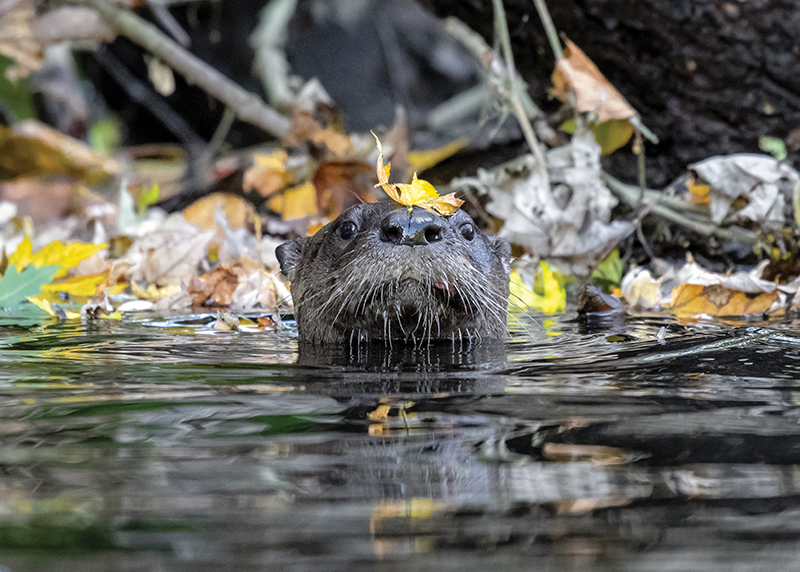
Among the most elusive creatures on the lower Farmington, river otters are always a treat to see. They are fast and agile fishers with unmistakable character.
For decades, MDC, a nonprofit municipal corporation, controlled the flow of water in the Farmington River, supplying drinking water to its eight nearby communities.
If the referendum passed and construction of the tunnel was allowed, it would mean that approximately 52,000 gallons of water per day would be siphoned from the Farmington River, almost certainly lowering the water level, and impacting the ecology and natural beauty of the river in a negative way.
“We had to get the people saying, ‘This is not a good idea,’” remembers David Sinish, who, at the time, was a new FRWA board member. Sinish, 77, knows the Farmington River well, both as a canoe and kayak paddler. In 2019, he also wrote the seminal A Short History of the Farmington River and the Quest for a National Wild and Scenic River Designation, and is one of the river advocates who has worked on both the Upper and Lower Farmington River designations.
Another standout was Culver Modisette, a former advertising executive and president of FRWA. Sinish said he was “extremely helpful” in getting votes and in setting up dates so that local radio stations could talk about preventing MDC from diverting drinking water from the Farmington River.
Meanwhile, other advocates for saving the Farmington River pounded the pavement with flyers and asked help from the Hartford Courant, with articles and editorials.
After the MDC referendum was defeated, Sinish said, “We all took a collective sigh of relief, but knew the tunnel would be proposed again.”
Fortunately, two Connecticut Congressional leaders stepped in and helped. In 1980, Representative Toby Moffett suggested using the National Wild and Scenic Act of 1968 as a tool for long-term river conservation and protection, and in 1985, Congresswoman Nancy Johnson, known for her policy expertise, introduced legislation for the Farmington River’s “wild and scenic” designation. It made all the difference in the world.
The rest is history.
It took 12 or more years for the Upper Farmington River to attain “wild and scenic” status, and roughly the same amount for the Lower Farmington River and Salmon Brook designation.
“A lot of close friendships were made with people who are still alive today,” said Nathan Frohling, executive director of FRWA from 1988–1994. “We actually did something, and did it together, and that’s a real meaningful thing to do.”
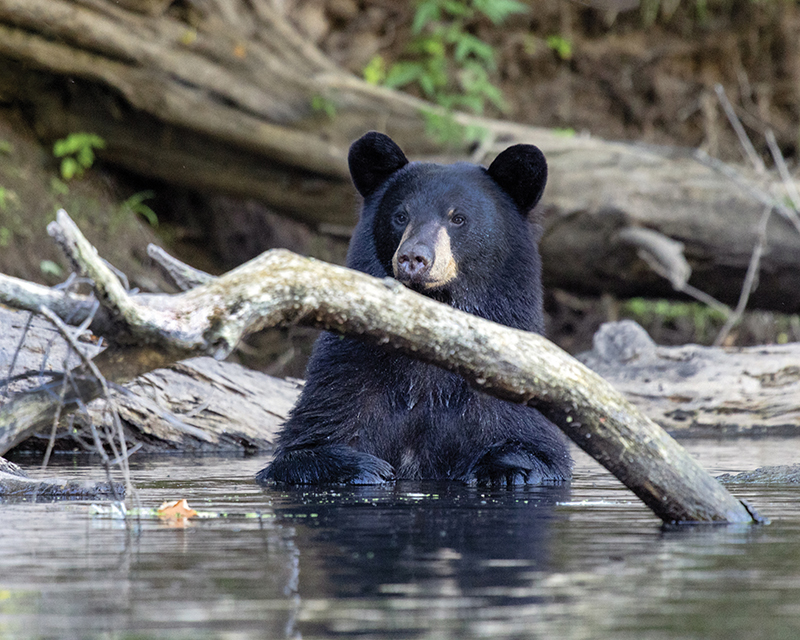
Many black bears have found our trash to be easier pickings than foraging, but nothing offers relief on a 90-degree day like the river.
Today, the management of the river includes a skillful collaboration with the Farmington River Watershed Association, the Connecticut Department of Energy and Environmental Protection, the Metropolitan District Commission, the National Park Service, the Army Corps of Engineers, the Farmington River Angler’s Association, the Farmington Valley Trout Unlimited, and many more. An advisory body, The Farmington River Coordinating Committee, ensures that all these entities move forward.
Value and Beauty Today
For a river to be federally designated “wild and scenic,” it must be free-flowing and possess one or more “outstandingly remarkable values” known as ORV’s.
One of these values is fish and wildlife, which the Farmington River has in spades.
“Most people would consider the Farmington River the best trout stream in Connecticut,” said Torrey Collins, manager of the Upcountry Sports Fishing fly shop in Hartland. “It certainly is one of the top trout streams in the Northeast.”
Collins said the Farmington River has a bottom release tailwater (from the dams) which means that it stays cooler in the summer, maintains a flow, and stays a little warmer in the winter, creating ideal conditions for brooks, browns, and rainbow trout.
The river also has a high catch rate. “Two or three years ago, DEEP gave us a fish per mile figure. It was an estimate of 5,900 trout in two miles. That’s 2,900 trout per mile,” Collins said.
In addition to fish, the region’s wildlife has prospered. Liz Lacey, a community planner/river manager with the National Park Service, Region 1, in Springfield, Massachusetts, is impressed with the wildlife that inhabits the Farmington River. “Before the designation was put in place, there weren’t any bald eagles. Now, you see them all the time,” she said.
Rick Warters, a resident of Simsbury and the photographer who captured the stunning photographs for this story, is another who is awed by the abundance of animals. “The diversity of wildlife that comes through this corridor is amazing.”
An avid kayaker, Warters said last year he spent over 500 hours paddling parts of the Farmington River, photographing black bears, otters, great blue herons, ospreys, wood ducks, and mergansers, to name a few. He is also astonished by the river’s beauty.
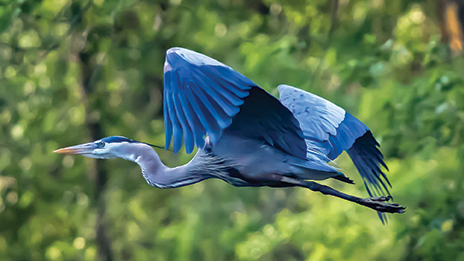
Great blue herons are ubiquitous along the Farmington. Once in the air, their six-foot wingspan keeps them aloft seemingly effortlessly.
“In the Farmington River, you don’t ever have a long view, like you might have on the Connecticut River. Instead, you’ve got hills on both sides and trees that surround you. So, you are kind of enveloped in greenery during the summer, and that gives you a great feeling of comfort.”
Another “outstandingly remarkable value” of the Farmington River is its accessibility and recreational opportunities. Besides fishing, it is a mecca for camping, boating, swimming, tubing, canoeing, kayaking, hiking, biking, and birding, to name a few.
Looking to the Future
“One of the biggest issues we face right now is development pressure,” said Aimee Petras, executive director of FRWA. She sees it popping up in the watershed almost daily, from private owners selling a parcel of riverfront property that might get scooped up by a developer, to local communities desiring to build more affordable housing and grabbing any patch of unused, vacant land to fulfill those needs.
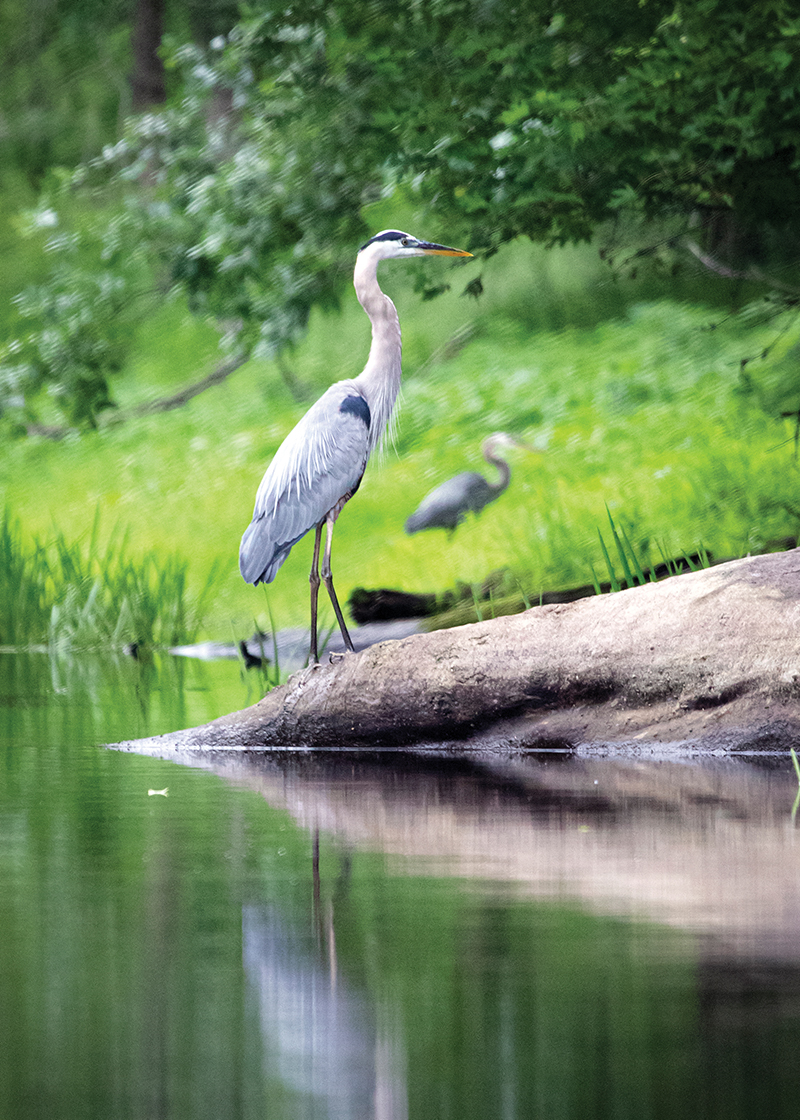
Great blue herons are wading feeders and can be spotted along the edge of the river for its entire length.
“I hope that the towns would appropriately protect the river and demand from developers that they think about things like storm water shunting into the river,” she said.
Another concern from stakeholders is potential overuse. In the 2022 Annual Report to the Farmington River Coordinating Committee, chairman Roger Behrens writes, “Managing the river’s recreational use to minimize resource degradation…is an ongoing challenge. This treasure needs to be appreciated and protected.”
The good news is that there are many checks and balances in place to ensure that the Farmington River is protected and safeguarded for generations to come.
In sum, if you know of a free-flowing, unspoiled river that might qualify for “wild and scenic” designation, persevere. The road to designation is long and arduous, but worth the fight, as the citizenry of the Farmington River Valley have proven.
Bill Hobbs is a contributing writer and columnist for Estuary magazine and The Times of New London, CT. He welcomes your comments and can be reached at whobbs246@gmail.com.

